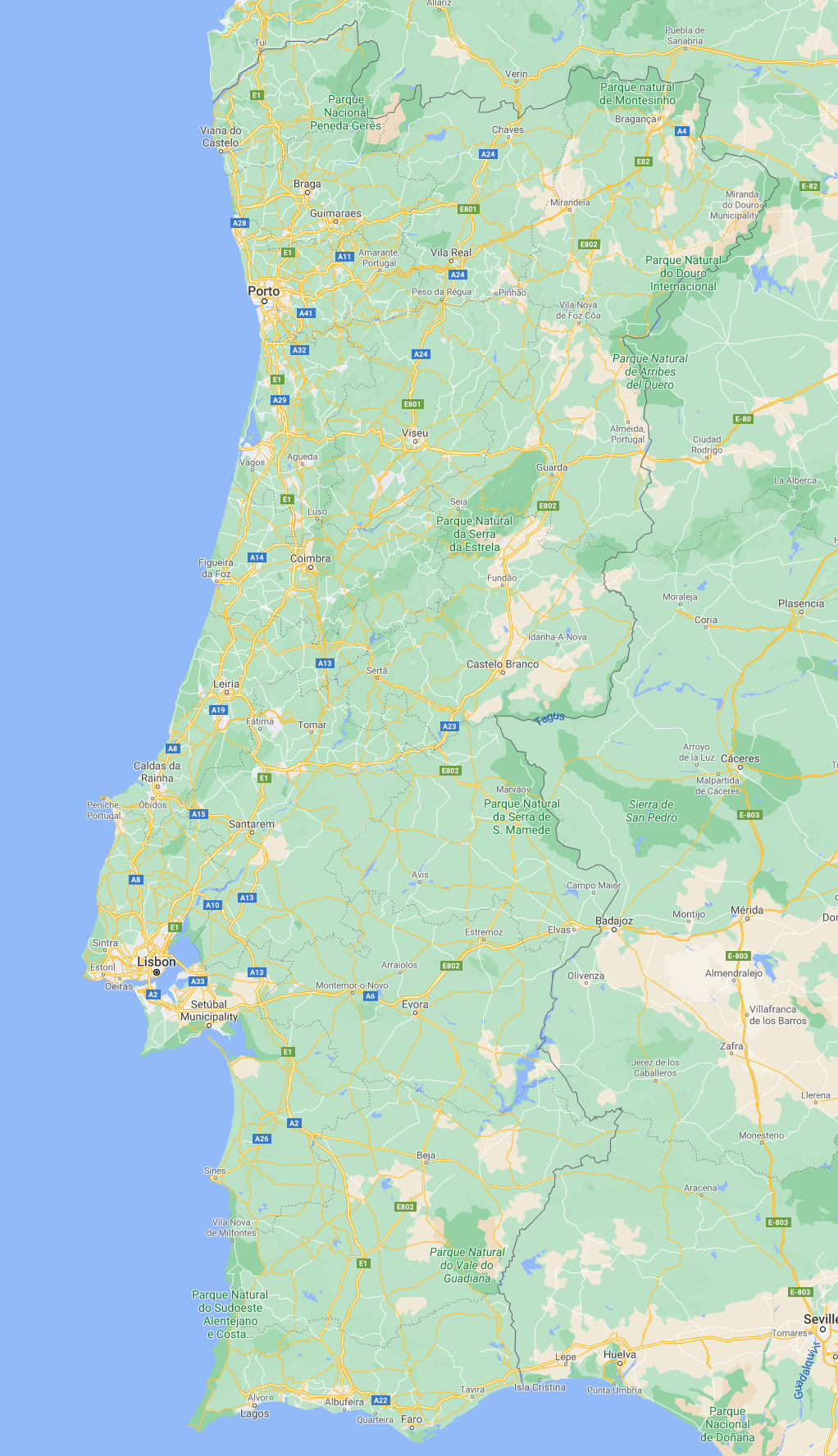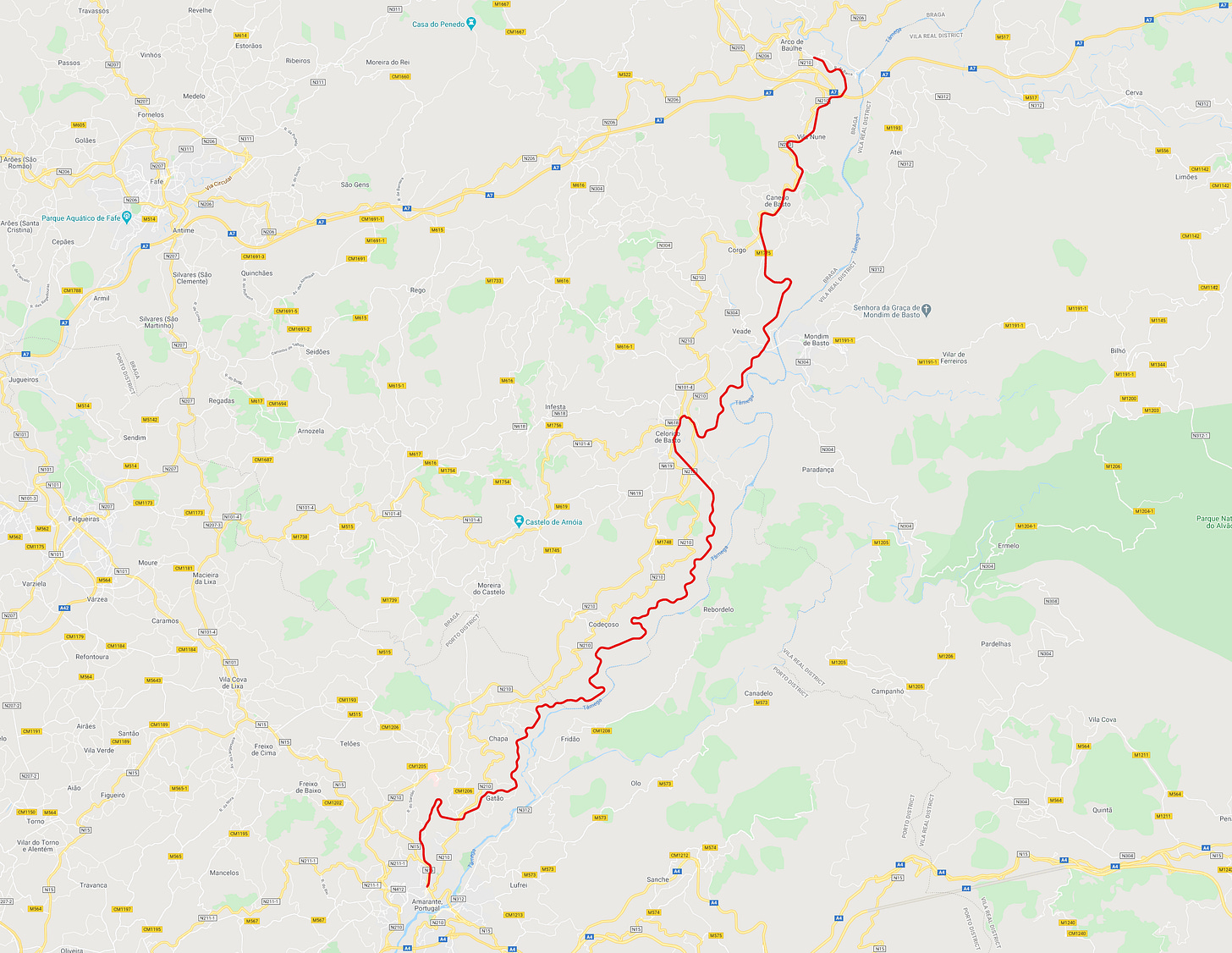Amarante
Why I chose to live here.

When having the freedom to choose where to live we need to narrow down the scope of the search to something manageable. This applies to choosing a neighbourhood in a big city, a city or region within a country, or a country. I’ve chosen Portugal as my next place to live for reasons I may get into in a different letter, but it could have easily been arbitrary; an exercise in fixing variables and then dialling in. After choosing Portugal, the question became where specifically? I’ve chosen Amarante. Here’s why.
There are many wonderful places to live in Portugal. In general, the further away from Lisbon, Porto, and the coasts, places become cheaper and more countryside. I was looking for a place that’s no more than an hour or two drive from an international airport, which practically means Lisbon and Porto’s; I wanted a countryside place that’s private and with some land; and, I wanted nature at my doorstep with the ability to easily go hiking. Searching by the criteria of distance measured in time is tricky because you can’t just put circles on a map, it depends primarily on accessibility. So I started the search quite wide.
The wonderful Alentejo region was my first candidate — around Évora would satisfy my requirements — but I considered that it might get too hot in summers and with time, given climate change. Really nice places closer to the border with Spain were too far.

I looked north. The entirety of the Porto District satisfied the airport criteria; it is sliced west-east by the fast — and tolled — A4 motorway so accessibility is good. It has milder temperatures, more rain, and has higher humidity compared with the southern regions. Porto district is the source of Port and Vinho Verde wines and its southern border is the wide and impressive Douro river that comes all the way from Spain.
Amarante sits on the Tâmega river, a tributary to the Douro. It’s both a municipality (60,000 inhabitants, 300km²) and the name of the main city (12,000 residents). It’s about 40 minutes drive to Porto and its airport through the toll road — about €6 each way — or double that time on the untolled, but good, local roads that pass villages and towns along the way. The city itself is relatively small compared with cities that are about 15 minutes drive away like Vila Real and Penafiel. There’s a regular train to Porto (under 1.5 hours, €3.5) that departs from nearby Marco de Canaveses, with a connection to Lisbon from Porto (add 2.5 hours) . There’s a bus service to Porto from Amarante’s central bus station (40 minutes, €7). These connection options were important because I knew that I might need to occasionally travel to Porto if I get work there. 40 minutes each way isn’t great, but isn’t bad either if done once or twice a week. (Amarante itself used to have a train station, but although it’s still standing it’s unused.)
Amarante’s town centre has a large bridge over the Tâmega and an imposing church. In summer there are celebrations and music festivals (those were cancelled this year, obviously). The main tourist strip — two sections of a street divided by the bridge — is charming, narrow, and restrained, and seems to survive on business from locals rather than be a tourist trap; there are no chain stores, restaurants, or coffee shops. (All these places have a 4-and-above star reviews because I assume they couldn’t survive without being good given that they are primarily for locals.) At my original visit and since then there is active rejuvenation of the town’s centre; buildings are being refreshed, more parking sorted, etc.

The Ecopista do Tâmega that starts/ends in Amarante is a 39km flat cycle and walking path following the Tâmega river; it was created on top of a train line that was shut in 2009. Amarante is on the Rota do Romanico, a network of 58 Romanesque buildings (mainly churches) dotted throughout the larger region. And, it seems, it’s also on a branch of Portuguese Caminho de Santiago because I see the signs and shell symbols. Of less importance to me, but still here for others, are a water park, a golf course, a thermal spa, and a Relais & Châteaux 5-star hotel with a Michelin star restaurant.
Having some of these things around is nice and useful, of course, but they are also significant from an investment point-of-view. While I was looking to live in Amarante and be part of the community, it’s helpful to take note, even based on anecdotes, that the city is thriving and then assume that property prices have a chance of increasing.
One major benefit of Amarante for me was the existence of Instituto Empresarial do Tâmega (IET), an incubator and the place where I have my office. It’s a modern, relaxed, and wonderfully organised hub for companies that need small offices or larger workshops. It allowed me to have had a ‘soft landing’ here both in terms of quickly setting up a work place and for getting to know people. It was extremely helpful. (From day one of arrival IET had kindly given me a free office for a couple of months until I get sorted; after that my 13m² office cost €111/month.) I’m not sure this sort of place exists in other northern towns.
I wanted to be close to nature. Amarante is close to several serras, mountain ranges, such as Serra do Marão and Serra da Aboboreira, which is dotted with ancient dolmens. Further away are major nature attractions such as Serra da Estrela, Arouca Geopark, and Parque Nacional da Peneda-Gerês. There’s an abundance of nature and history around.
Ultimately, though, we choose places to live mostly by heart, not mind. My first visit to Amarante was really pleasant. I drove in on a pre-COVID Sunday from the northeast and happened on a busy Leitão — piglet, although I didn’t know at the time — place (Filhos de Moura) in one of the villages. I sat down outside and was served the fixed meal while observing families enjoying themselves and having fun. In some way I felt that I already belonged. Then driving towards Amarante I noticed IET, which I visited the next morning to ask about an office and was shown around the incubator and industrial estate it is in. I stayed in a lovely hotel (Casa do Ribeirinho, €28/night!) near the river and bridge and the host, a computer scientist, was very patient with my questions. For dinner I happened to eat at a family run restaurant (Taberna) that served small dishes which I really enjoyed (go there for the Prego with cheese). I’ve enjoyed the local sweets in some of the nice confeitarias around town overlooking the river (Doçaria Mário, Confeitaria da Ponte). During the trip I’ve seen only two properties and one of them near Amarante I really liked. The combination of these experiences helped cement Amarante as a good choice.
Choosing where to live is difficult and our choice is not necessarily based on hard facts and research, just a good feeling. Narrowing down choices, even arbitrarily, was important in order to avoid choice paralysis, where I would have never acted on the desire to make the big change I was looking for.
Notes
The best place to get an idea of property prices in the Iberian peninsula is at Idealista. The amount of land I could afford with a fairly tight budget was remarkable; it’s so much more affordable than anything comparable in the UK.
Leitão is really good! But it’s served with a side portion of guilt. I’ve only had it once again since that first time.


Inspiring account Saar, I can only dream.
When I talked to you and you said you were moving to Amarante, I googled it and thought, "why is he moving to the middle of nowhere???" But it makes a lot more sense now that you describe it. It just seemed so remote at first. That's amazing that they have the business incubator to help you get on your feet, bravo! Now are you ready for a cosmic twist? Last week I bought some Rose from Portugal on a lark from Trader Joes. I didn't read the label, it was just reasonably priced and looked good. Well, today I got the email for this posting, then we opened it later in the afternoon. And guess where it's from! https://photos.app.goo.gl/EEpr2uoqNCcD75QT9 (it is good btw)